|
A powerful interest in satellite communications and science continues in the 2000s among ham radio operators around the world. A boom is underway as hams continue to build and send sophisticated Amateur Radio satellites and amateur-related satellites to orbit at a record pace.
Here, in chronological order, are the numerous Amateur Radio and amateur-related satellites of the first decade of the 21st century:
2000: ASUSat, OPAL, JAWSAT
A complex set of hamsats was launched January 27, 2000, from the Commercial Launch Facility at Vandenburg Air Force Base in California. The small satellites were blasted to orbit on a Minotaur rocket, also referred to as OSPSLV, which stands for Orbital Suborbital Program Space Launch Vehicle.
That rocket was built from parts recycled from retired nuclear missiles. A six-story launch vehicle, it combined the first and second stages of decommissioned Minuteman-2 missiles with third and fourth stages from Orbital Sciences' commercial air-launched Pegasus rocket. The launch proved that the combo was capable of ferrying satellites to space.
The Strategic Arms Reduction Talks (START) treaty between the United States and the former Soviet Union resulted in the decommissioning of hundreds of Minuteman-2 missiles. On January 27, 2000, some 350 Minuteman-2 missiles were in storage, which meant plenty of parts were available. Recycling parts saved money, according to Minotaur's builders. Using recycled parts from Minuteman missiles saves a third of the usual cost for launching payloads, they said.
Here are the sophisticated small hamsats aboard the Minotaur launch:
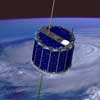 |
ASUSat1 from the Aerospace Research Center at Arizona State University, Tempe, Arizona, was launched by the Minotaur on January 27, 2000 from Vandenburg Air Force Base in California. The hamsat held an amateur packet radio system and a 2-meter/70-cm FM voice repeater.
2000: OPAL-OSCAR 38
Stanford University's OPAL also was launched by the Minotaur on January 27, 2000 from Vandenburg Air Force Base in California to Earth orbit where it was labeled OPAL-OSCAR 38 (OO-38).
Stanford University's Satellite Systems Development Laboratory (SSDL), Stanford Aeronautics and Astronautics, developed the spacecraft called OPAL which was an acronym for Orbiting Picosatellite Automated Launcher.
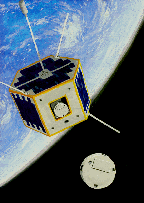 |
2000: StenSAT
StenSAT Amateur Radio Picosatellite also was launched by the Minotaur on to Earth orbit on January 27, 2000, from Vandenburg Air Force Base in California, as part of OPAL-OSCAR 38. In space, OPAL ejected StenSAT into its own orbit on February 10, 2000. (See above: OPAL-OSCAR 38)
StenSAT was built by Amateur Radio operators at Washington, D.C., as part of Stanford University's OPAL Orbiting Picosatellite Automated Launcher project. Stensat was one tiny spacecraft in a cluster of six picosatellites that were ejected from the OPAL-OSCAR 38 (OO-38) platform into their own orbits.
StenSAT was a mere 12 cubic inches in size and weighed only 8.2 ounces. It was a Mode J single-channel FM voice repeater with uplink at 145.84 MHz and downlink at 436.625 MHz. Periodically, StenSAT would transmit packets of telemetry.
2000: Thelma and Louise
Also known as Thunder and Lightning, these Santa Clara University ParaSat Program Artemis Picosatellite Project also was launched by the Minotaur on January 27, 2000 from Vandenburg Air Force Base in California. It, too, elements were part of the OPAL-OSCAR 38 (OO-38) package. Thelma and Louise were ejected from OPAL on February 12, 2000. (See above: OPAL-OSCAR 38)
2000: Weber-OSCAR 39
JAWSAT stood for Joint Air Force Academy – Weber State University Satellite. It was built at the Center for Aerospace Technology (CAST) at Weber State University, Utah. It also was launched by the Minotaur on January 27, 2000, from Vandenburg Air Force Base in California.
JAWSAT carried a clutch of small satellites to be released in space. Once JAWSAT reached its target orbit of 466 miles above Earth, it deployed four independent amateur-radio and amateur-related satellites. In turn, one of those satellites deployed other satellites. JAWSAT's six digital cameras recorded the deployment of each of the satellites.
In addition, JAWSAT had a permanently-mounted Multi-Payload Adaptor (MPA) built by students working with aerospace professionals. That framework held two other experiments — NASA's Plasma Experiment Satellite Test (PEST) and Weber's Attitude Controlled Platform (ACP).
JAWSAT's four little satellites. The four individual tiny satellites were ejected into orbit by JAWSAT in this order:
- ASUSat, designed, built, tested and operated by students at Arizona State University, was the first of its tiny size referred to as a nanosatellite. It was launched as a technology demonstrator for low cost spacecraft. The spacecraft took pictures of Earth and served as a communications relay station for Amateur Radio operators.
- OCSE, the U.S. Air Force Research Laboratory's Optical Calibration Sphere Experiment, was a 3.5 meter diameter kapton/aluminum balloon designed to orbit Earth for two years to test ground tracking systems.
- OPAL, the Orbiting Picosat Automatic Launcher was designed and built at Stanford University. OPAL-1 also was known as Squirt-2 because, including itself, it carried six tiny picosatellites to be deployed in space including a picosat sent by Santa Clara University's Artemis team and two tether research craft for the U.S. miltiary. Also in the cluster was StenSat, an Amateur Radio satellite. The 30-lb. OPAL's mission was to demonstrate a capability for launching multiple picosatellites from a mothership.
- FalconSat was developed by U.S. Air Force Academy cadets to study how charged particles can build up and then wreck satellites' onboard computer systems. The so-called Charging Hazards and Wake Studies experiment on FalconSat was a longer duration experiment than those that had been performed in earlier flights.
OPAL's clutch of six satellites. The five picosatellites "squirted" out into space by OPAL-1 and OPAL-1 itself:
-
DARPA Picosat-1A weighed about 1.5 lbs. and was designed by the The Aerospace Corp. to carry out technology research for the Defense Advanced Research Program Agency (DARPA).
DARPA Picosat-1B weighed about 1.5 lbs. and also was built by the The Aerospace Corp. to carry out technology research for DARPA.
Artemis Picosat weighed slightly more than 1 lb. and was built at Santa Clara University to carry out technology research.
MASat-1, also known as Hockeypuck, weighed slightly more than 1 lb. and was built by the Stanford Mentors Team for Amateur Radio use.
StenSat weighed about half a pound and was designed and built for Amateur Radio use.
OPAL-1, the 30-lb. Orbiting Picosat Automatic Launcher "mothership" built at Stanford University.
-
PEST, the Plasma Experiment Satellite Test sponsored by NASA's Marshall Space Flight Center.
ACP, Weber State University's Attitude Controlled Platform.
An Expansive Project. JAWSAT was built by students working alongside aerospace professionals. Initially planned to be only a pulsed-plasma thruster to train U.S. Air Force Academy cadets, the project grew to include several universities, aerospace companies, the Air Force Research Laboratory and NASA.
OSPSLV is a relatively small rocket that can can lift 750 lbs. to a 400-nautical-mile sun-synchronous orbit. That is 1.5 times the capability of the commercial Pegasus XL rocket.
The multiple payload adapter was built by One Stop Satellite Solutions (OSSS) of Ogden Utah. It allows Minotaur to carry one large payload and up to four smaller payloads.
The Minotaur OSPSLV. While Pegasus is launched from an airplane at high altitude, the OSPSLV is launched from the ground similar to the existing Taurus space rocket.
Minotaur can blast off from a government pad at Vandenberg Air Force Base, California, as well as commercial spaceports at Wallops Island, Virginia, Cape Canaveral, Florida, Vandenberg AFB, California, and Kodiak Island, Alaska.
To ensure no adverse impacts to the U.S. commercial space launch capability, all payload customers must be U.S. government agencies or be sponsored by such agencies. The Secretary of Defense holds approval power for each Minotaur OSPSLV launch.
A second Minotaur is scheduled to launch the Air Force Research Laboratory's MightySat 2.1 payload in March 2000.
-
JAWSAT JAWSAT served as what is known in the satellite business as a "bus" for the several deployable payloads and the Plasma Experiment Satellite Test (PEST).
The telemetry stream from JAWSAT, including data from PEST, was transmitted on Amateur Radio frequencies. Amateur Radio operators (hams) contributed to the experimental program by recording the downlinked data transmitted at rates as high as 38.4 kb/s on 437.175 MHz or 2403.2 MHz.
ASUSat Arizona State University's ASUSat contained amateur packet hardware and a 2-meter/70-cm FM voice repeater. ASUSat was a NASA Space Grant project and Arizona State University's first student-designed satellite.
StenSat The tiny StenSat, which was a satellite within another satellite, the Orbiting Picosat Automatic Launcher (OPAL), was strictly a ham satellite. It was designed by hams for use by hams. It was developed by a group of amateur enthusiasts in the Washington, D.C., area as part of Stanford University's OPAL project.
StenSat operated as a single-channel Mode J FM voice repeater. The uplink frequency was 145.84 MHz. The downlink frequency was 436.625 MHz. StenSat transmited 1200 baud AX.25 telemetry. Additionally, Amateur Radio operators were to be able to ''ping'' the satellite by transmitting a six-digit DTMF (TouchTone) command to the receiver uplink.
2000: AMSAT-OSCAR 40
Phase-3D was launched on an Ariane 5 rocket from Kourou, French Guiana, on November 16, 2000, to become AMSAT-OSCAR 40.
-
AMSAT and AO-40 — Recovering From Disaster
AO-40 was intended to allow its amateur radio operators to assess the effectiveness of a highly eccentric orbit -- known as a Molniya orbit -- for long-distance point-to-point communications.
 |
-
First photo of Earth from AO-40
SCOPE. The satellite has two full-color CCD digital cameras. SCOPE is an acronym for "Spacecraft Camera experiment for Observation of Planets and the Earth". JAMSAT, the Japan AMSAT Association, designed and built the SCOPE module for AO-40.
SCOPE takes full color pictures of Earth from the satellite's high-altitude orbit. Although there are several amateur satellites that have CCD cameras, most are monochrome and in low Earth orbits. SCOPE is capable of showing Earth floating in space like the Apollo astronauts saw our planet on their way to the Moon.
As Earth sensors, the SCOPE cameras are alignment tools in the satellite's three-axis attitude control system, which includes three momentum wheels, an Earth sensor and a Sun sensor.
JAMSAT has a plan for an amateur satellite that would fly away from Earth to another planet. Because the SCOPE cameras are capable of seeing relatively bright stars, a similar camera could be a star tracker for that future satellite's flight guidance system. SCOPE also could capture the image of a destination planet.

|
Click one of these links to see the:
FIRST PHOTO OF EARTH FROM AO-40 SECOND PHOTO OF EARTH FROM AO-40 |
Momentum wheels. The satellite's magnetically suspended momentum wheels provide three-axis control of the spacecraft.
GPS, FDMA, RUDAK. AO-40 was expected to demonstrate use of GPS for managing and monitoring operation of an Amateur Radio satellite. Hams hoped to use the satellite to study technology and operating procedures for a multiple-access transponder using a technique known as Frequency Division Multiple Access (FDMA).
The digital RUDAK communications processor was activated. RUDAK was to provide digital store-and-forward message service, and serve as the primary communications path for interacting with various experiments on board the satellite known as CEDEX, GPS, MONITOR, and SCOPE.
-
AMSAT and AO-40 — Recovering From Disaster
2000: Saudi-OSCAR 41
SaudiSat-1a was launched September 26, 2000, aboard a converted Soviet ICBM ballistic missile from the Baikonur Cosmodrome, along with two other Amateur Radio satellites on the same launch. (See below: SaudiSat-OSCAR 42)
SO-41 and SO-42 were built in the Kingdom of Saudi Arabia by the Space Research Institute at the King Abdulaziz City for Science and Technology. The pair of hamsats have digital store-and-forward bulletin board systems (BBS) as well FM voice repeaters.
2000: Saudi-OSCAR 42
SaudiSat-1b was launched September 26, 2000, aboard a converted Soviet ICBM ballistic missile from the Baikonur Cosmodrome, along with two other Amateur Radio satellites on the same launch. (See above: SaudiSat-OSCAR 41)
SO-41 and SO-42 were built in the Kingdom of Saudi Arabia by the Space Research Institute at the King Abdulaziz City for Science and Technology. The pair of hamsats have digital store-and-forward bulletin board systems (BBS) as well FM voice repeaters.
2001: Starshine-OSCAR 43
The Starshine-3 hamsat was launched to a 300-mi.-high orbit by NASA on a Lockheed Martin Athena I rocket on September 30, 2001, from the Kodiak Launch Complex on Kodiak Island, Alaska.
The space mission, known as Kodiak Star, was the first planned flight to orbit from the then-new Kodiak Launch Complex in Alaska. NASA and the Department of Defense (DoD) collaborated on the project. The Kodiak Star payload was four small satellites — PICOsat, PCSat, SAPPHIRE, and Starshine 3.
Starshine-3 was a 37-in.-diameter, 200-lb. ball covered with 1,500 aluminum mirrors polished by 40,000 student volunteers in the United States and 25 other countries. While it was in space, volunteer Amateur Radio operators and students around the world monitored packet radio telemetry transmissions every two minutes from the satellite on 145.825 MHz. The satellite was heard last on January 9, 2002.
The hamsat's main mission was to educate school children in space and radio sciences. In addition to building and tuning in to radio signals from Starshine-3, students also tracked the satellite visually during morning and evening over-flights by recording flashes of light reflected from the mirrors on the ball.
2001: Nav-OSCAR 44
Prototype Communications Satellite (PCSat) was launched by NASA on a Lockheed Martin Athena I rocket on September 30, 2001, from the Kodiak Launch Complex on Kodiak Island, Alaska.
The space mission, known as Kodiak Star, was the first planned flight to orbit from the then-new Kodiak Launch Complex in Alaska. NASA and the Department of Defense (DoD) collaborated on the project. The Kodiak Star payload was four small satellites — PICOsat, PCSat, SAPPHIRE, and Starshine 3.
The microsat PCSat was built by U.S. Naval Academy midshipmen. The small hamsat housed an Automatic Position Reporting System (APRS) packet radio digipeater designed for use by stations employing mobile or portable transceivers. Downlinked information from PCsat was fed into a central web site.
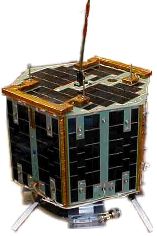 Sapphire NO-45 before launch STANFORD IMAGE |
The microsat SAPPHIRE was launched by NASA on a Lockheed Martin Athena I rocket on September 30, 2001, from the Kodiak Launch Complex on Kodiak Island, Alaska.
The space mission, known as Kodiak Star, was the first planned flight to orbit from the then-new Kodiak Launch Complex in Alaska. NASA and the Department of Defense (DoD) collaborated on the project. The Kodiak Star payload was four small satellites — PICOsat, PCSat, SAPPHIRE, and Starshine 3.
SAPPHIRE was built by students at Stanford University and Washington University – St. Louis. Sapphire's main mission was to test two sets of Tunneling Horizon Detector infrared sensors built by the Jet Propulsion Laboratory and Stanford University. The satellite also carried a digital camera and voice synthesizer.
2000: Malaysian-OSCAR 46
The Malaysian hamsat TiungSAT-1 was launched September 26, 2000, aboard a converted Soviet ICBM ballistic missile from the Baikonur Cosmodrome. It was one of three Amateur Radio satellites on the same flight.
This satellite is out of chronological order in this list. However, it is in OSCAR number order. While MO-46 was launched before the hamsats SO-43, NO-44, and NO-45, it received its OSCAR number after them.
Malaysia's first microsatellite, TiungSAT-1 was named after that nation's mynah bird. TiungSAT-1 was built at the University of Surrey in the U.K. for Astronautic Technology (M) Sdn. Bhd. (ATSB) and the Malaysian government.
MO-46 was a mixture of Amateur Radio satellite and amateur-related satellite. It carried commercial land and weather imaging payloads as well as Amateur Radio FM and FSK communication equipment.
2002: Radiosputnik 21/Kolibri-2000
Students in Sydney, Australia, and Obninsk, Russia, moved into the world of Amateur Radio in space when the Russians wanted to demonstrate that space is of vital interest to mankind and that educating young people about space flight and research is very important. Russia's School Scientific-Research Micro-Satellite (SSRMS) program — the International School Space Program — wanted to involve elementary and secondary school children in designing research experiments for microsatellites.
The tiny satellite was built by the Special Workshop of Space Research Institute (IKI) of the Russian Academy of Sciences, Tarusa, Kaluga. The Sydney and Obninsk students named it Kolibri-2000. Kolibri means hummingbird. The complete name of RS-21was Russian-Australian Scientific and Educational Microsatellite KOLIBRI-2000.
The satellite rode the Russian Progress M-17 cargo freighter up to the International Space Station in December 2001. The IKI engineers had attached a radio-controlled remote launching port to the Progress capsule that held Kolibri while docked at the ISS. Then, as the Progress rocket backed away and departed from the ISS, the 44-pound Kolibri was ejected into space March 20, 2002.
Kolibri had no engine or thrusters of its own. After it popped off the cargo freighter, Kolibri dropped slowly, circled Earth 711 times, and burned up in Earth's atmosphere after about four months. While falling into the atmosphere during the late winter and spring months, it sent down telemetry data and digitally recorded voice messages on the downlink frequency of 145.825 MHz.
-
More on Kolibri-2000: Kolibri-2000 Shows Youngsters That Space is Vital to Mankind
Two picosats built by radio amateurs in AMSAT-France, and known before launch as IDEFIX CU1 and IDEFIX CU2, were launched on May 3, 2002, by the European Space Agency (ESA) on Ariane-4 rocket flight V151 from Kourou, French Guiana. The Ariane also ferried the SPOT-5 photo satellite to orbit. In space they became BreizhSAT-OSCAR 47 and BreizhSAT-OSCAR 48.
In space at an altitude around 500 miles, the tiny hamsats remained fastened to the Ariane rocket third stage. Both transmitted recorded narrow-band FM (NBFM) voice messages and digital telemetry data. (See below: BreizhSAT-OSCAR 48)
Both satellites carried 600 watt-hour batteries. It was thought before the flight that each would have enough battery power to work up to 40 days. In the end, BO-47 transmitted BPSK telemetry data at 145.840 MHz for only 32 days. The BO-47 transmitter had only one-tenth the output power of BO-48.
2002: BreizhSAT-OSCAR 48
Two picosats built by radio amateurs in AMSAT-France, and known before launch as IDEFIX CU1 and IDEFIX CU2, were launched on May 3, 2002, by the European Space Agency (ESA) on Ariane-4 rocket flight V151 from Kourou, French Guiana. The Ariane also ferried the SPOT-5 photo satellite to orbit. In space they became BreizhSAT-OSCAR 47 and BreizhSAT-OSCAR 48.
In space, at an altitude around 500 miles, the tiny hamsats remained fastened to the Ariane rocket third stage. Both transmitted recorded narrow-band FM (NBFM) voice messages and digital telemetry data. (See above: BreizhSAT-OSCAR 47)
Both satellites carried 600 watt-hour batteries. It was thought before the flight that each would have enough battery power to work up to 40 days. In the end, BO-48 transmitted BPSK telemetry data at 435.270 MHz for only 14 days. the BO-48 transmitter had an output power 10 times higher than BO-47.
2002: AATiS OSCAR-49
The German amateur satellite SAFIR-M was launched by Russia from the Baikonur Cosmodrome in Kazakhstan on December 19, 2002, on a converted Russian ICBM ballistic missile. In space, it became AATiS OSCAR-49, or AO-49
AATiS is a group devoted to promoting Amateur Radio in schools in Germany.
2002: Saudi-OSCAR 50
The Saudi Arabian satellite Saudisat 1-C was launched by Russia from the Baikonur Cosmodrome in Kazakhstan on December 20, 2002, on a converted Russian ICBM ballistic missile. In space, it became Saudi-OSCAR-50 (SO-50).
SO-50 was built in the Kingdom of Saudi Arabia by the Space Research Institute at the King Abdulaziz City for Science and Technology. (See above: Saudi-OSCAR 41 and Saudi-OSCAR 42)
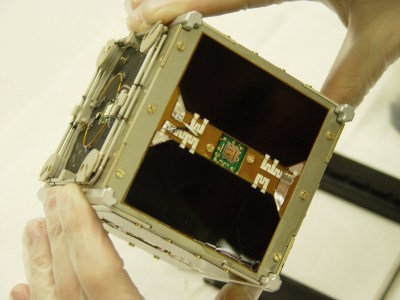 DTUsat before launch CLICK TO ENLARGE IMAGE PROVIDED BY DTU |
CubeSats are referred to as nanosats and picosats because they are tiny, measuring just 4x4x4 inches. To be exact, they are 10 ccm satellites weighing less than 1 kg.
CubeSat Project started in 1999 as a collaborative effort between California Polytechnic State University San Luis Obispo and Stanford University's Space Systems Development Laboratory to provide a standard design for picosatellites with a common deployer. The idea was to reduce costs and development time, while increasing accessibility to space with frequent launches. Dozens of high schools, colleges, and universities around the world are developing CubeSats.
more about the CubeSat Project »»
more about Stanford SSDL »»
more about Cal Poly PolySat »»
Six CubeSats were launched on June 30, 2003, on one ROCKOT booster by EUROCKOT Launch Services GmbH from the Plesetsk Cosmodrome in Northern Russia to 510-mile-high, sun-synchronous orbits. Riding the same rocket were the non-amateur Czech Republic's MIMOSA satellite and the Canadian Space Agency's MOST satellite.
2003: DTUsat
DTUsat was designed and built by students at the Technical University of Denmark (DTU). DTUsat did not work in orbit. The satellite had the amateur radio callsign OZ2DTU. It was one of the six CubeSats launched on June 30, 2003, on one ROCKOT booster from the Plesetsk Cosmodrome in Northern Russia to 510-mile-high, sun-synchronous orbits. more info
2003: AAU CubeSat
AAU CubeSat is a student satellite project at the University of Aalborg, Denmark. The hamsat transmited on 437.450 MHz. AAU CubeSat worked in orbit for 2.5 months before the battery ran down. Some data was downlinked from the satellite, although the transmitter signal was weak. The satellite was one of the six CubeSats launched on June 30, 2003, on one ROCKOT booster from the Plesetsk Cosmodrome in Northern Russia to 510-mile-high, sun-synchronous orbits. A second CubeSat project has been started at Aalborg University. AAUSAT-II will carry a science payload including a gamma-ray and X-ray detector. more info
2003: CanX-1
CanX-1 by the Institute for Aerospace Studies, Space Flight Laboratory, at the University of Toronto, Canada. The satellite has the amateur radio callsign VA3SFL. It was one of the six CubeSats launched on June 30, 2003, on one ROCKOT booster from the Plesetsk Cosmodrome in Northern Russia to 510-mile-high, sun-synchronous orbits. more info
2003: Quakesat
Quakesat from the Space Systems Development Laboratory at Stanford University. The satellite transmits on 436.675 MHz and has the amateur radio callsign KD7OVB. CubeSats are called nanosats or picosats because they measure a tiny 4x4x4 inches. QuakeSat was a triple CubeSat because it measured 4x4x12 inches. The satellite was designed to collect from space the extremely low frequency (ELF) radio signals that are earthquake precursors. QuakeSat had to large enough to include a one-foot-long magnetometer that extended on a telescoping boom. The receiver was provided by QuakeFinder. It was one of the six CubeSats launched on June 30, 2003, on one ROCKOT booster from the Plesetsk Cosmodrome in Northern Russia to 510-mile-high, sun-synchronous orbits. more info or even more info
2003: CUTE-1
CUTE-1 from Japan's Tokyo Institute of Technology, Laboratory for Space Systems. The satellite transmits CW on 436.8375 MHz CW and data on 437.470 MHz. It has the amateur radio callsign JQ1YCY. It was one of the six CubeSats launched on June 30, 2003, on one ROCKOT booster from the Plesetsk Cosmodrome in Northern Russia to 510-mile-high, sun-synchronous orbits. more info
2003: XI-IV
XI-IV from the University of Tokyo, Japan. The satellite transmits data on 437.490 MHz and CW on 436.8475 MHz. It has the amateur radio callsign JQ1YCW. It was one of the six CubeSats launched on June 30, 2003, on one ROCKOT booster from the Plesetsk Cosmodrome in Northern Russia to 510-mile-high, sun-synchronous orbits. more info
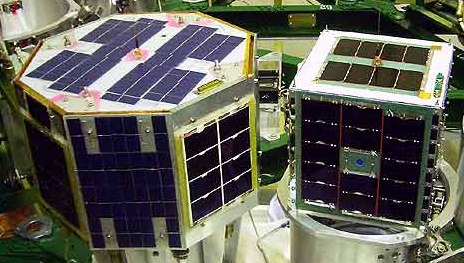 June 2004 AMSAT photo of Echo, right, before launch, mounted next to its octagonal fellow traveler Unisat 3 at Baikonur Cosmodrome, Kazakhstan. Unisat was a science satellite built by students of La Sapienza University of Rome. Launched on the platform with Echo and Unisat were the Argentine microsats Latinsat-C and -D, also known as Aprizesat 1 and 2; the Saudi Arabian microsats Saudisat 2, Saudicomsat 1 and Saudicomsat 2; and the French satellite DEMETER. |
AMSAT North America sent its Echo to orbit on June 29, 2004. Previously referred to as OSCAR-E, the satellite was the first in a new series of small user-friendly repeater satellites. In space it was named AMSAT-OSCAR 51 (AO-51).
Echo is a microsatellite cube sporting electricity-generating solar panels on all six sides. It was ferried to space by Russia using an SS-18 intercontinental ballistic missile (ICBM) converted into a Dnepr space rocket. Echo was one of eight spacecraft from France, Saudi Arabia, Italy and the United States on board the Dnepr rocket as it lifted off from a silo in the ground at Baikonur Cosmodrome in Kazakhstan. All of the payloads were inserted into sun-synchronous orbits at altitudes around 450 miles.
The satellite is similar in size and weight to the original AMSAT microsatellites of 1990. However, Echo incorporates 21st century hamsat electronics and RF technology.
The analog and digital VHF/UHF FM radios aboard Echo are similar to those aboard the UOSAT-OSCAR 14 (UO-14) and AMRAD-OSCAR 27 (AO-27) hamsats.
Echo offers:
- telemetry at 435+ MHz
- analog FM voice communications
- digital communications with APRS
- two seven-watt high power UHF FM downlink transmitters for the downlink that can be operated simultaneously
- four miniature VHF FM receivers weighing less than two ounces each for communications and command-and-control
- two downlink transmitter channels
- simultaneous voice and data,
- wide-coverage multi-mode receiver covering 100 KHz to 1.3 GHz
 VuSat-OSCAR 52 before launch |
AMSAT-India sent its first satellite, HamSat, to orbit on May 5, 2005. Known on orbit as VUSat-OSCAR 52 (or VO-52 HamSat), the 94-lb. microsat was launched from Satish Dhawan Space Centre (SDSC) in Sriharikota, India, as an auxiliary payload on India's Polar Satellite Launch Vehicle (PSLV-C6) rocket. It was the ninth flight of a PSLV rocket. The primary payload on the Indian Space Research Organisation (ISRO) flight was the government's remote sensing satellite CARTOSAT-1. Both the satellites were ferried to a nearly-circular polar sun synchronous orbit at approximately 390 miles altitude with an inclination of 97.8 deg with respect to the equator.
VO-52 provides amateur radio UHF/VHF communications. One of its transponders was built by ham radio operators in India with the help of ISRO. The second transponder was built by a Dutch amateur radio operator William Gerard Leijenaar, a graduate student in engineering at the Higher Technical Institute, Venlo, The Netherlands.
The satellite is spin stabilized. It spins at about 4 RPM.
VO-52 specs:
- UHF Uplink and VHF Downlink
- Uplink transponder frequency: 435.250 MHz
- Downlink transponder frequency: 145.900 MHz
- Beacon frequencies: 145.860 MHz CW telemetry and 145.936 MHz unmodulated carrier
- Transponder bandwidth: 60 kHz
- Transmitter output power: 1 watt
- Antennas: VHF and UHF turnstiles
- Communication modes: CW, SSB, FM
- Electrical power: Gallium Arsenide solar panels charging a Lithium Ion battery
- Onboard computer: MAR 31750 processor in the spacecraft's electronic bus management unit for attitude control, telemetry, telecommand for ground control, sensor and actuator functions.
AMSAT-INDIA » ISRO » AMSAT VUSAT FAQ »
 Click to enlarge image of PCSAT-2 mounted on the ISS |
Midshipman at the U.S. Naval Academy Satellite Lab constructed the PCsat-2 amateur radio APRS digipeater equipment that is attached to the outside of the International Space Station (ISS) in Earth orbit.
Launch to the ISS was delayed by the postponement of all shuttle flights after the Columbia tragedy in 2003. PCsat-2 finally was transported to the station on July 26, 2005, by shuttle Discovery on flight STS-114, NASA's return-to-space mission, the first shuttle flight after the loss of shuttle Columbia in 2003.
PCsat-2 is a small electronic communications station built in a suitcase, which was carried outside the space station on August 3, 2005, by astronaut Soichi Noguchi on a spacewalk. He attached the case to a truss.
Known as a Passive Experiment Container (PEC), the suitcase is left open to the dark vacuum of space. One side of the case has a solar panel to generate electricity for communications. Antennas stick out from the suitcase into space.
The PCSat-2 communications system operates like a hamsat in coordination with ARISS (Amateur Radio aboard the International Space Station). It has an FM repeater for use in voice communications with the ISS crew; a PSK-31 multi-user transponder; an AX.25 packet radio system for use as a UI digipeater; and for telemetry, command, control; an APRS packet digipeater; and a telemetry data transmitter. APRS is the Automatic Position Reporting System used to track vehicles and networks.
Many parts are similar to those on the the original PCsat-1 (NO-44).
The U.S. Naval Academy (USNA) Amateur Radio Club operates the spacecraft within the USNA Small Satellite program. PCsat-2 communications operate in the International Telecommunications Union (ITU) Amateur Satellite Service in cooperation with the Amateur Radio aboard the International Space Station (ARISS) organization.
PCSAT-2 VHF uplink and UHF downlink:
- Uplink frequency: 145.825 MHz
- Downlink frequency: 435.275 MHz
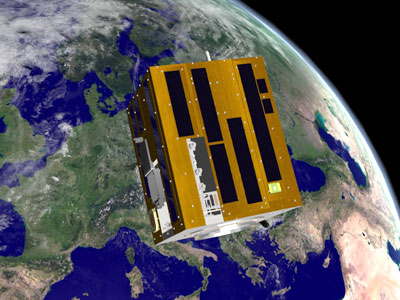 XO-53 SSETI Express orbits Earth in this concept by Morten Bisgaard of Aalborg University in Denmark |
Students from twelve different European countries built SSETI Express as the first pan-European student satellite. The spacecraft was launched October 27, 2005, on a Cosmos 3M rocket from the Plesetsk Cosmodrome in the Archangel region of Russia.
It is flying in a low-Earth, Sun-synchronous orbit, 426 miles above Earth. After it arrived in space, AMSAT assigned the number XO-53 to SSETI.
SSETI Express ferried to orbit three educational CUBESAT pico-satellites developed by universities.
SSETI, which stands for Student Space Exploration and Technology Initiative, was created by the European Space Agency (ESA) Education Department to involve European students in real space missions to give students hands-on experience and build their interest in working in space science to ensure a workforce for the future.
In 18 months, 15 teams of students at 10 universities in nine countries designed, built and tested SSETI Express.
The small spacecraft measures about two feet on each side. It was expected to operate in orbit for about two weeks to two months.
On board the SSETI Express spacecraft at launch were three very tiny pico-satellites. Each of those extremely small satellites weighed about 2 lbs.
The three CUBESATs dropped off in space by SSETI Express are:
- XI-V from the University of Tokyo, Japan.
- UWE-1 from the University of Würzburg, Germany.
- Ncube-2 from the Andoya Rocket Range in Norway.
- deploy the CUBESATs using a so-called T-Pod device built in Canada by the University of Toronto Institute for Aerospace Studies (UTIAS ) Space Flight Laboratory.
- take pictures of Earth.
- act as a test-bed and technology demonstration for the future European Student Earth Orbiter.
- function as a ham radio radio transponder for the duration of its flight.
- SSETI Express, launched October 27, 2005
- ESEO, European Student Earth Orbiter, to be launched in 2008
- ESMO, European Student Moon Orbiter, to be launched in 2010-2012
Later, an electrical power failure rendered the main spacecraft inoperable. SSETI was toggling between safe mode and recovery mode, and its voltage was oscillating from 0-24 volts. Contact with the spacecraft was lost.
Mission control said there was a small but significant possibility of recovery. If radio contact returns, operators will look for telemetry and data from the satellite's experiments.
To spur interest in the project, ESA provided telemetry capture software for radio amateurs. It also offered a prize to the amateur radio station providing the most telemtry after launch.
Uplink and downlink frequencies:
- Voice uplink – 437.250 FM 67Hz CTCSS
- Voice downlink – 2401.835 FM
- Packet uplink/downlink – 437.250 9k6 packet
- Packet downlink – 2401.835 38k4 packet
| Learn more: | ||||
| SSETI: | SSETI Express | ESA – SSETI | SSETI Express | UTIAS Lab |
| Cubesats: | XI-V, Tokyo | UWE-1, Würzburg | Ncube-2, Norway | |
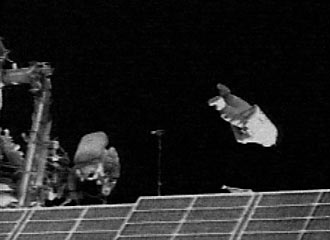 NASA TV image of departing Suitsat (right center). |
What do you do with a worn-out spacesuit if you're a couple of hundred miles above Earth aboard the International Space Station? If you were the Expedition 12 crew, you would stuff it with some science instruments and a radio transmitter, and toss the old suit overboard. It would float around the outside of the station for a while then gradually descend into the thicker atmosphere below where it would burn up. Along the way, students on the ground around the world would learn a lot about space and science.
Science fiction? Satsuit is real and was launched by hand from the orbiting International Space Station on February 3, 2006. AMSAT designated Suitsat-1 as AMSAT OSCAR 54 (AO-54).
According to Frank H. Bauer, KA3HDO, ARISS international chairperson and AMSAT-North America vice president for human spaceflight programs, the pioneering Suitsat-1 experiment has been tremendously successful despite weak signals:
- This ARISS international team was able to fabricate, test and deliver a safe ham radio system to the ISS team just three weeks after the international space agencies agreed to the Suitsat experiment.
- The spacesuit satellite was deployed successfully from the ISS, demonstrating to professional space agencies that this can be safely done.
- The student's creative artwork, signatures and voices were carried aboard the spacesuit.
- CD pictures of of the late Roy Neal, K6DUE, and the late Thomas Kieselbach, DL2MDE, radio amaturs who contributed to the ARISS program, were aboard Suitsat-1.
- Suitsat focused media attention on the project and on amateur radio.
- Suitsat captured the imagination of students and the general public worldwide through its unique experiment.
STO table listing all amateur radio satellite launches »
AMSAT summary of the status of all Amateur Radio satellites »
ARRL » SUITSAT» ARISS» AMSAT »
Hamsat Chronology:
The next page continues our story with the amazing plans for sophisticated and powerful Amateur Radio satellites to be launched in the near Future:
| PREVIOUS PAGE The 1990s |
NEXT PAGE The Future |
| Satellites | Search STO | STO cover | K3RXK | Questions | Feedback | Suggestions | ||||||||
| © 2005 Space Today Online | ||||||||||||||